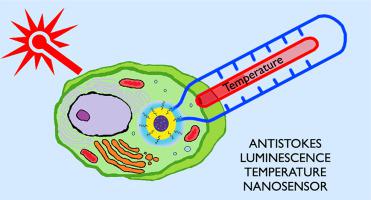Spectrochimica Acta Part A: Molecular and Biomolecular Spectroscopy ( IF 4.3 ) Pub Date : 2020-06-19 , DOI: 10.1016/j.saa.2020.118627 Olga E Sarmanova 1 , Sergey A Burikov 1 , Kirill A Laptinskiy 2 , Olga D Kotova 1 , Ekaterina A Filippova 1 , Tatiana A Dolenko 1

|
The luminescence intensity ratio method, exploiting the temperature-dependent luminescence of the thermally coupled energy levels, is regarded as a very promising approach for optical temperature measurement at the cellular level. In this study, it was found that bare NaYF4:Yb3+/Tm3+ nanoparticles cannot be used as a cellular thermosensor in principle because of their tendency to aggregate, which significantly affects the luminescent properties of the complex, introducing uncertainty in the intensity ratio measurement. NaYF4:Yb3+/Tm3+ up-conversion nanoparticles, coated with polyethylene glycol (PEG) and carboxyl groups (COOH), on the other hand, proved to be promising candidates for the role of thermosensors. For the first time the temperature sensitivity of the NaYF4:Yb3+/Tm3+@PEG@COOH thermosensor was calculated in water and in biotissues. It was found that the sensitivity of the thermosensor increased by 1.3 times during the transition from water to egg white and urine – from 1.17% × K−1 to 1.58% × K−1. This effect is associated with the chemical composition of the studied media. The results obtained suggest that using upconversion nanocomplexes as primary thermosensors is still difficult.
中文翻译:

上转换基于NaYF4:Yb3 + / Tm3 +的纳米复合材料的体外温度感测:特殊性和陷阱。
利用热耦合能级的温度依赖性发光的发光强度比方法,被认为是在细胞水平上进行光学温度测量的非常有前途的方法。在这项研究中,发现裸NaYF 4:Yb 3+ / Tm 3+纳米颗粒原则上不能用作细胞热敏传感器,因为它们易于聚集,这会显着影响复合物的发光性能,从而导致不确定性。强度比测量。NaYF 4:Yb 3+ / Tm 3+另一方面,涂覆有聚乙二醇(PEG)和羧基(COOH)的上转换纳米粒子被证明是热传感器作用的有希望的候选者。首次在水中和生物组织中计算了NaYF 4:Yb 3+ / Tm 3+ @ PEG @ COOH热传感器的温度敏感性。发现从水到蛋清和尿液过渡期间,热敏传感器的灵敏度提高了1.3倍-从1.17%×K -1到1.58%×K -1。这种作用与所研究培养基的化学组成有关。获得的结果表明,使用上转换纳米复合物作为主要热传感器仍然很困难。











































 京公网安备 11010802027423号
京公网安备 11010802027423号